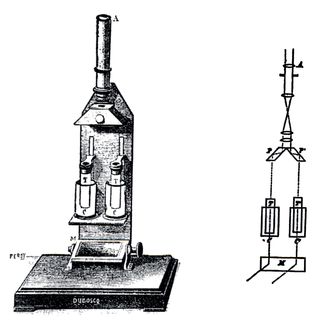An enzyme immunoassay is any of several immunoassay methods that use an enzyme bound to an antigen or antibody. These may include:
An enzyme immunoassay is any of several immunoassay methods that use an enzyme bound to an antigen or antibody. These may include:

The enzyme-linked immunosorbent assay (ELISA) is a commonly used analytical biochemistry assay, first described by Engvall and Perlmann in 1971. The assay uses a solid-phase type of enzyme immunoassay (EIA) to detect the presence of a ligand in a liquid sample using antibodies directed against the protein to be measured. ELISA has been used as a diagnostic tool in medicine, plant pathology, and biotechnology, as well as a quality control check in various industries.
ICT may refer to:
Eia or EIA may refer to:
Emit may refer to:

In pharmacology, the international unit (IU) is a unit of measurement for the amount of a substance; the mass or volume that constitutes one international unit varies based on which substance is being measured, and the variance is based on the biological activity or effect, for the purpose of easier comparison across substances. International units are used to quantify vitamins, hormones, some medications, vaccines, blood products, and similar biologically active substances.
Pseudocholinesterase may refer to:

An immunoassay is a biochemical test that measures the presence or concentration of a macromolecule or a small molecule in a solution through the use of an antibody (usually) or an antigen (sometimes). The molecule detected by the immunoassay is often referred to as an "analyte" and is in many cases a protein, although it may be other kinds of molecules, of different sizes and types, as long as the proper antibodies that have the required properties for the assay are developed. Analytes in biological liquids such as serum or urine are frequently measured using immunoassays for medical and research purposes.

Hypersensitivity pneumonitis (HP) or extrinsic allergic alveolitis (EAA) is a rare immune system disorder that affects the lungs. It is an inflammation of the airspaces (alveoli) and small airways (bronchioles) within the lung, caused by hypersensitivity to inhaled organic dusts and molds. People affected by this type of lung inflammation (pneumonitis) are commonly exposed to the dust and mold by their occupation or hobbies.
Enzyme multiplied immunoassay technique (EMIT) is a common method for qualitative and quantitative determination of therapeutic and recreational drugs and certain proteins in serum and urine.
Activation, in chemistry and biology, is the process whereby something is prepared or excited for a subsequent reaction.
Casein kinase, a type of kinase enzyme, may refer to:

Batroxobin, also known as reptilase, is a snake venom enzyme with Venombin A activity produced by Bothrops atrox and Bothrops moojeni, venomous species of pit viper found east of the Andes in South America. It is a hemotoxin which acts as a serine protease similarly to thrombin, and has been the subject of many medical studies as a replacement of thrombin. Different enzymes, isolated from different species of Bothrops, have been called batroxobin, but unless stated otherwise, this article covers the batroxobin produced by B. moojeni, as this is the most studied variety.
Minretumomab (CC49) is a mouse monoclonal antibody that was designed for the treatment of cancers that express the TAG-72 antigen. This includes breast, colon, lung, and pancreatic cancers. Apparently, it never got past Phase I clinical trials for this purpose.
Eva Engvall, born 1940, is one of the scientists who invented ELISA in 1971.
In biochemistry and pharmacology, GABA transaminase enzymes comprise a family of transaminases which degrade the neurotransmitter GABA. GABA transaminases include 4-aminobutyrate transaminase, which catalyzes the chemical reaction:

In physical and analytical chemistry, colorimetry or colourimetry is a technique used to determine the concentration of colored compounds in solution. A colorimeter is a device used to test the concentration of a solution by measuring its absorbance of a specific wavelength of light.
A cloned enzyme donor immunoassay (CEDIA) is a competitive homogenous enzyme immunoassay. This assay makes use of two component fragments of an enzyme which are each individually inactive. Under the right conditions in solution these fragments can spontaneously reassemble to form the active enzyme. For use in biochemical assays one of the enzyme fragments is attached to an analyte of interest. The analyte-enzyme-fragment-conjugate is still able to reassemble with the other enzyme fragment to form an active enzyme. However it is unable to do this if the analyte is bound to an antibody.
An enzyme modulator is a type of drug which modulates enzymes. They include enzyme inhibitors and enzyme inducers. In an homogenous assay, "an enzyme modulator ... is covalently linked to the ligand which competes with free ligand from the test sample for the available antibodies."
FEIA may refer to:

Fluorescence polarization immunoassay (FPIA) is a class of in vitro biochemical test used for rapid detection of antibody or antigen in sample. FPIA is a competitive homogenous assay, that consists of a simple prepare and read method, without the requirement of separation or washing steps.